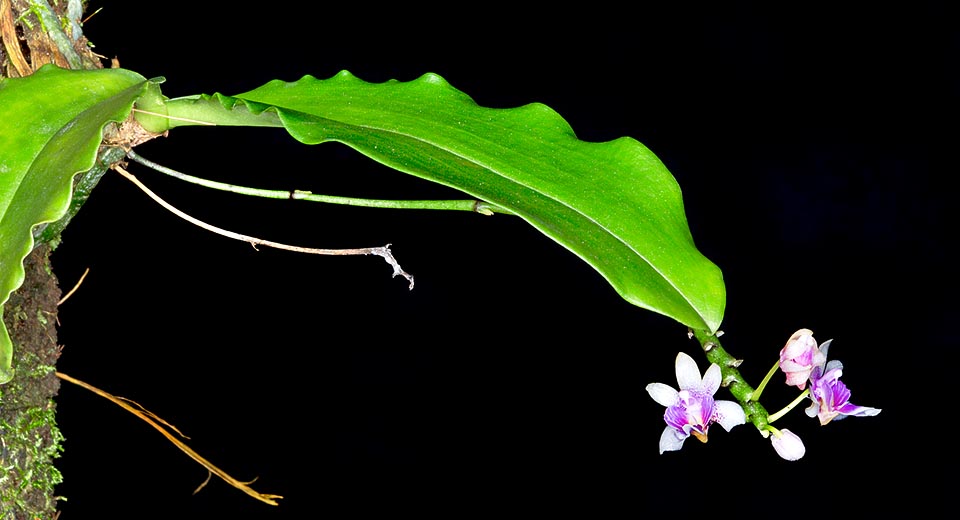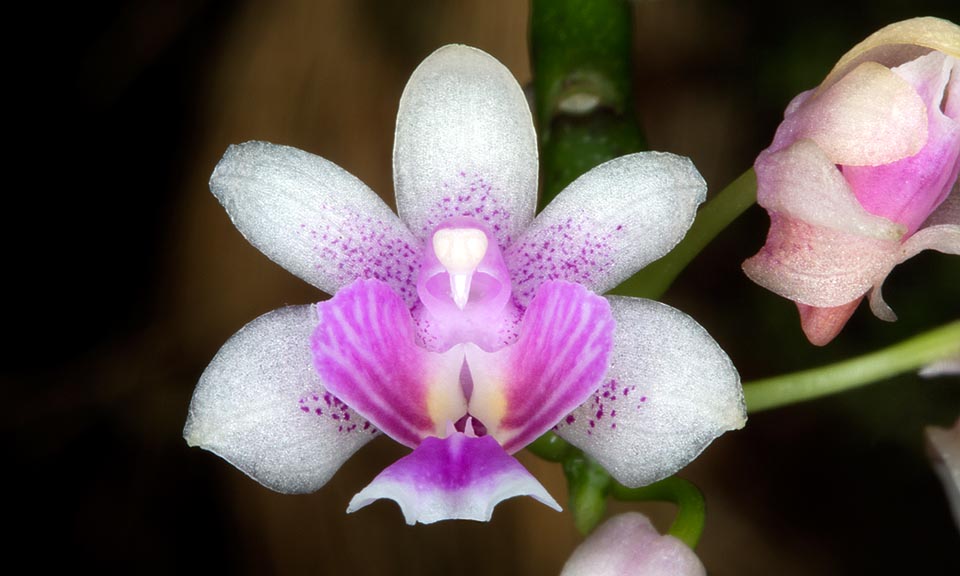Family : Orchidaceae

Text © Pietro Puccio

English translation by Mario Beltramini
The species is native to Andaman Islands, Assam, Bangladesh, Borneo, Cambodia, Himalaya, India, Java, Laos, Malaysia, Moluccas, Myanmar, Nepal, Philippines, Singapore, Sri Lanka, Sulawesi, Sumatra, Thailand and Vietnam, where it grows on the trees of the humid forests or on the rocks, often close to water streams, up to about 1600 m of altitude.
The generic name is the combination of the Greek substantives “φάλαινα” (phalaina) = butterfly and “ὄψις“ (opsis) = look, with obvious reference; the specific name is the Latin adjective “deliciosus, a, um” = delicious.
Common names: da jian nang hu die lan (Chinese).
The Phalaenopsis deliciosa Rchb.f. (1854) is an epiphytic or lithophytic species with short stem, wholly hidden by the imbricate foliar bases, and elliptic to obovate-lanceolate leaves with obtuse or slightly pointed apex and wavy margins, 6-15 cm long and 3-5 cm broad, fleshy, of dark green colour and glossy. Lateral inflorescences, 8-18 cm long, at times ramified in the apical part, bearing several close flowers opening gradually for long time, of 1,5-1,8 cm of diameter, waxy, of whitish colour with sepals and petals dotted of pale purple, in particular near to the base, and pale purple streaked labellum.

Epiphyte or lithophyte of South-East Asia tropical forests, Phalaenopsis deliciosa has short stem and big leaves that may reach the 15 cm © Giuseppe Mazza
Biweekly fertilizations during the vegetative period utilizing a balanced hydrosoluble manure, with microelements, at ¼, or less, the dosage suggested on the package. It is usually mounted on trunks, on bark pieces or rafts of cork or of roots of arborescent ferns, with sphagnum at the base to maintain the humidity; if cultivated in pot the aeration of the compost is to be particularly cared, with the addition of inerts, and the waterings must be duly more spaced than those of the mounted plants to avoid dangerous stagnations at the roots. The floral stems are to be cut when completely withered, as they can bloom again for several years.

8-18 cm inflorescences, at times ramified in the apical part, with several close flowers, of 1,5-1,8 cm of diameter, gradually opening © Giuseppe Mazza
The species is reported in the appendix II of CITES (species whose trade is internationally ruled).
Synonyms: Phalaenopsis bella Teijsm. & Binn. (1862); Phalaenopsis hebe Rchb.f. (1862); Phalaenopsis wightii Rchb.f. (1862); Aerides latifolia Thwaites (1864); Phalaenopsis amethystina Rchb.f. (1865); Doritis wightii (Rchb.f.) Benth. & Hook.f. (1883); Doritis latifolia Trimen (1885); Doritis latifolia (Thwaites) Benth. & Hook. f. (1889); Phalaenopsis alboviolacea Ridl. (1893); Doritis philippinensis Ames (1908); Doritis steffensii Schltr. (1911); Doritis hebe (Rchb.f.) Schltr. (1913); Kingiella hebe (Rchb.f.) Rolfe (1917); Kingiella philippinensis (Ames) Rolfe (1917); Kingiella steffensii (Schltr.) Rolfe (1917); Phalaenopsis hebe var. amboinensis J.J.Sm. (1917); Kingidium deliciosum (Rchb.f.) H.R.Sweet (1970); Kingidium deliciosum var. bellum (Teijsm. & Binn.) O.Gruss & Roellke (1993); Kingidium philippinense (Ames) O.Gruss & Roellke (1995); Kingidium wightii (Rchb.f.) O.Gruss & Roellke (1995); Doritis deliciosa (Rchb.f.) T.Yukawa & K.Kita (2005); Kingidium deliciosum f. album O.Gruss (2006); Phalaenopsis deliciosa f. alba (O.Gruss) Christenson (2008).
→ For general notions about ORCHIDACEAE please click here.
